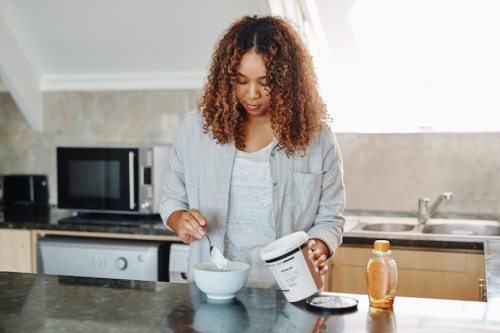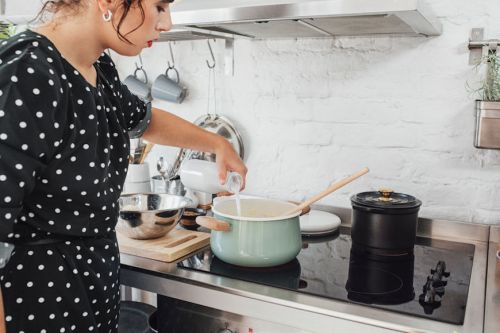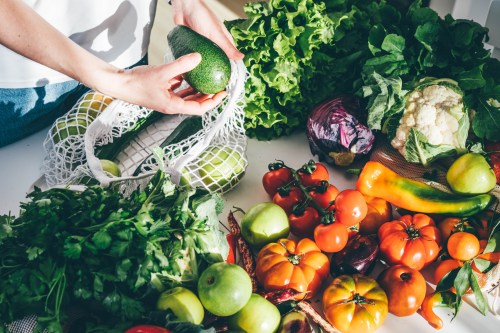Our editors independently select these products. Making a purchase through our links may earn Well+Good a commission
How to make homemade yogurt—whether you’re plant-based or want *all* the dairy
Everything you need to know about how to make homemade yogurt, whether you want to make a dairy-based version or a plant-based version.

If you’re big into DIY wellness, you may already make your own cashew milk or brew your own kombucha. But making your own homemade yogurt? That’s next level.
This might sound like a huge pain, but hear me out. While grocery stores are full of many dairy and non-dairy yogurt options, the benefit to making your own is that you can control the ingredients to get the exact health profile and taste you want. (A big plus, since so many brands sneak extra sugar in their recipes.)
Working with live probiotic cultures and thickening agents like xanthan gum can sound a little intimidating, but with some expert advice, you’ll have DIY yogurt mastered in no time. Here, author of Home Dairy with Ashley English and holistic nutritionist Ashley English shares her best tips on making homemade dairy-based yogurt while Thomas Pagot—creator of vegan food blog Full of Plants—reveals how to make a nut-milk based version.
Scroll down for tips on how to make homemade yogurt.

Ingredients for dairy-based yogurt:
- Milk: “The type of milk used in yogurt making is purely a matter of personal preference,” English says. It’s up to you whether you use skim, 1 percent, 2 percent, or whole milk. “If you’re looking to limit fat for whatever reason, then skim milk will be your go-to.” She says her family is a full-fat dairy household, so she uses whole milk when making homemade yogurt. “The mouth feel and texture will be a bit thicker with full fat, but it’s possible to include powdered gelatin or dry milk to augment the consistency if you opt to use a low- or no-fat milk,” she says.
- Starter culture: To make sure your homemade yogurt has those amazing probiotic benefits, you’ll need to get a starter culture (a mix of good bacteria that drives the fermentation process). “During dairy fermentation, such as with yogurt, bacteria found in milk and the air interact, rendering milk sugar—lactose—into lactic acid,” English says. Bacteria is basically key ingredient that turns your milk into yogurt; without it, you’re not going to get a good mix of probiotics, she adds.
- English says you can either start with store-bought yogurt for your initial batch or use a packet of dried yogurt culture ($37.95 for two boxes of ten). Once you’ve made your first batch of yogurt, she says you can use leftovers as the starter culture for about five to seven subsequent batches. At that point, the original starter will start to be less effective, English says, so you should use a bit of store-bought yogurt or that dried packet to beef up your probiotic supply again.
- Powdered gelatin or dried milk (optional): If you’re using milk with a lower fat content, English recommends using powdered gelatin ($20) or dried milk ($10.49) for added thickness. “Otherwise, most homemade yogurt tends to be somewhere in the runny to mildly runny camp,” she says.
- Sweetener of choice (optional): English likes her homemade yogurt plain, with no sweeteners, but adding agave, maple syrup, stevia, or another sweetener is also an option.
Ingredients for plant-based yogurt:
- Almonds: In his recipe, Pagot likes to make his nut milk from scratch. He prefers almond, but says any plant-based option works just fine. “Almond milk doesn’t taste better than soy, cashew, or coconut milk, it’s just different and a personal preference,” he says. But he adds that he prefers almond because it’s full of protein and is generally lower in calories than coconut milk.
- Thickening agents: Using a thickening agent with a plant-based yogurt helps it create a thick, yogurt-like texture. Pagot actually uses a blend of xanthan gum ($7.99) and locust bean gum ($12.99). “If you measure them correctly, they are very easy to use,” he says. “Xanthan gum helps thicken the yogurt and gives it a better mouthfeel.” If you don’t like gums (or can’t find them at the grocery store), he says potato starch or corn starch also works to thicken the yogurt.
- Agar-agar: Pagot says agar-agar ($12.75), a vegan alternative to gelatin, works a stabilizer. “It helps the yogurt set,” he explains.
- Yogurt starter: To keep your recipe vegan, Pagot says to look for a powder yogurt starter ($15.99). “It contains cultures that will work once added to the warm nut milk,” he says. “After several hours, it turns the nut milk into yogurt, giving it that tangy flavor.” He adds that the taste of various yogurt starters varies, so you may need to experiment a little before landing on one that tastes just right.
- Sweetener (optional): Just like with homemade dairy yogurt, if you want to sweeten up your vegan yogurt, have at it!
- How to store: Keeps up to four days in the refrigerator.

How to make homemade yogurt
The obvious answer: Use a yogurt maker or a machine like an Instant Pot that has a yogurt-making function. But in English’s opinion, it’s not a requirement. “You definitely do not need a yogurt machine to make yogurt at home. I don’t, and have been successfully making yogurt for years,” she says. However, she says there are some perks to having a yogurt machine. “They remove all of the temperature guesswork for you, and babysit your fledging yogurt with expert ease.”
If you don’t want to shell out for a new appliance, the only things you need to make homemade yogurt (besides the ingredients) are a saucepan, mason jars, a food thermometer, a stovetop, and an oven. Here’s the step by step:
- Heat up your milk. The first step to making your homemade yogurt—whether it’s dairy or nut-based—it to gently heat up the milk in a pan on the stove to about 180 degrees Fahrenheit. (For nut-based yogurt, Pagot adds his stabilizers and thickeners before heating up the milk, although you can also wait and add those in post-fermentation.) Bring it up to temperature slowly, stirring often, to prevent the milk from curdling.
- Add the active cultures. Once the milk is hot, take it off the heat and let it cool to 110 degrees Fahrenheit—the optimal temperature for bacterial growth. (Too hot and you risk killing your bacteria.) Then add in your yogurt culture. If using the powdered stuff, whisk it straight into your mix. If using store-bought yogurt as your culture, Epicurious suggests mixing together a small amount of your heated milk with the yogurt in a separate bowl to help it come up to temperature (a process called tempering) before adding into bigger milk mixture.
- Incubate. If you have a yogurt machine, pour your mix into the machine’s containers and follow the machine’s instructions to operate. If you do not have a yogurt machine, pour your mix into cleaned mason jars. Then, put your jars into an unheated oven with the light on. This is just to help safely store the yogurt and give it an insulated place to ferment at temperature. You’ll want to let it ferment for at least five hours, or overnight.
- Refrigerate. Next, put your yogurt in the fridge for about four hours to cool it down. Once it’s cool, you can add your thickening agents if the consistency isn’t what you want. This is also when you can add your sweetener of choice.
- Storing note: Homemade yogurts typically last in the fridge for four days.
Like making cheese or kombucha, making homemade yogurt requires patience. But in the end, you’ll have a yummy, healthy treat that you can feel confidence about eating because you know *exactly* what’s in it.
Originally published March 14, 2019. Updated March 6, 2020.
One you have your yogurt, incorporate it into one of these delicious oatmeal recipes or as a topping on this vegetarian chili.
Sign Up for Our Daily Newsletter
Get all the latest in wellness, trends, food, fitness, beauty, and more delivered right to your inbox.
Got it, you've been added to our email list.










